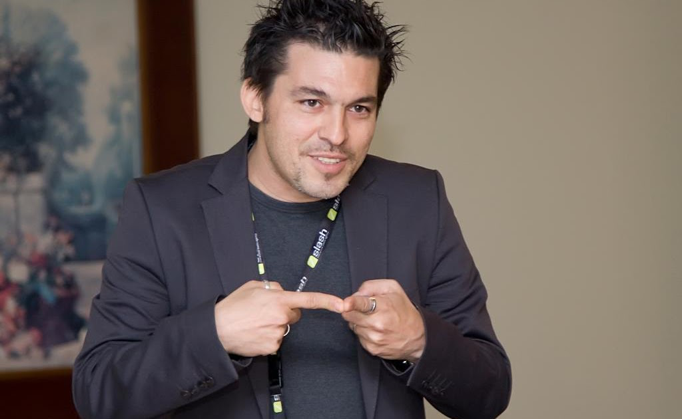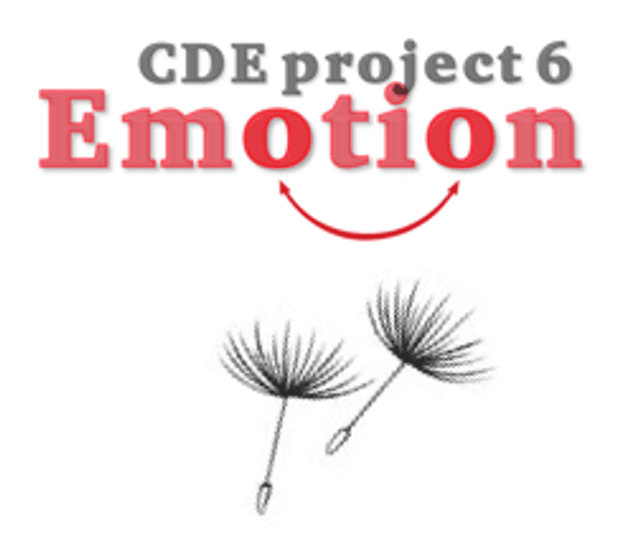CDE project 6: the use and misuse of emotion. Section 3.1: the science of emotions.
- Written by
- Francesco Ambrogetti
- Added
- June 29, 2017
Click here for the full contents for project 6: the use and misuse of emotion.
3.1. What are emotions?
By Francesco Ambrogetti
Why emotions drive donations (and most of our life)
In order to understand why and how emotions are so crucial in the donor experience, we need to understand why people give to charities.
For centuries, philosophers, economists, theologians, psychologists and ordinary people have wondered and constructed theories to explain the strange behaviour to share something valuable (like money and time) with strangers, without receiving anything in return.
From the perspective of the Cartesian theory of rationality (‘Cogito ergo sum’), the homo economicus of John Stuart Mill and Ricardo, and also from the evolutionary point of view of Darwinian survival of the fittest, the fact that someone gives something to a stranger without an equivalent in return has posed serious problems
To some economists, giving is simply a selfish act: we donate for cancer research because we have the chance of being impacted in the future and therefore we could benefit from research advancement. But why do we give to individuals, communities, animals, museums, etc. we have no connection with, and we will never have the chance to meet or know them?
Other economists and psychologists, such as James Andreoni [1]maintain that the act of giving to unknown entities and individuals is not totally free, rather it is an act motivated by the increasing self-esteem. We feel a better person by giving (or others will consider us as a better person because we are generous), and therefore giving is a bit like being pampered putting on a nice pair of gloves to warm up our cold hands (‘warm glow theory’). But if giving is not a rational choice and is not a self-esteem mechanism, because many people give anonymously – let’s think about billion $ donated for victims of disasters in
remote part of the world or for a rare disease such as ALS through the ice bucket challenge- why do we keep giving money away to unknown people and organisations?
It is interesting to note that overall donations grow or remain stable even during periods of economic crisis, such as the recent ones. While philosophers, economists and theologians formulated their ideas to explain the ‘anomaly’ of giving, neurosciences, with the capacity to look into what is happening in the brain while we perform actions like giving money, has changed everything.
The same act of making a donation is not a rational behavior. Dan Ariely, Professor of Psychology and Behavioral Economics at Duke University, demonstrated that how much we care and donate for an issue and the magnitude of the problem for which we donate are not correlated [2]
People gave more to 9/11 or Hurricane Katrina, which affected a relatively small number of people compared to malaria and HIV/AIDS.
It’s not that we care less for bigger problems or we give more money to things that are less important. It's all about our emotions, said Ariely: if something can activate our emotions then we get to care and then we get to do something about it; and if something doesn't activate our emotions nothing much happens.
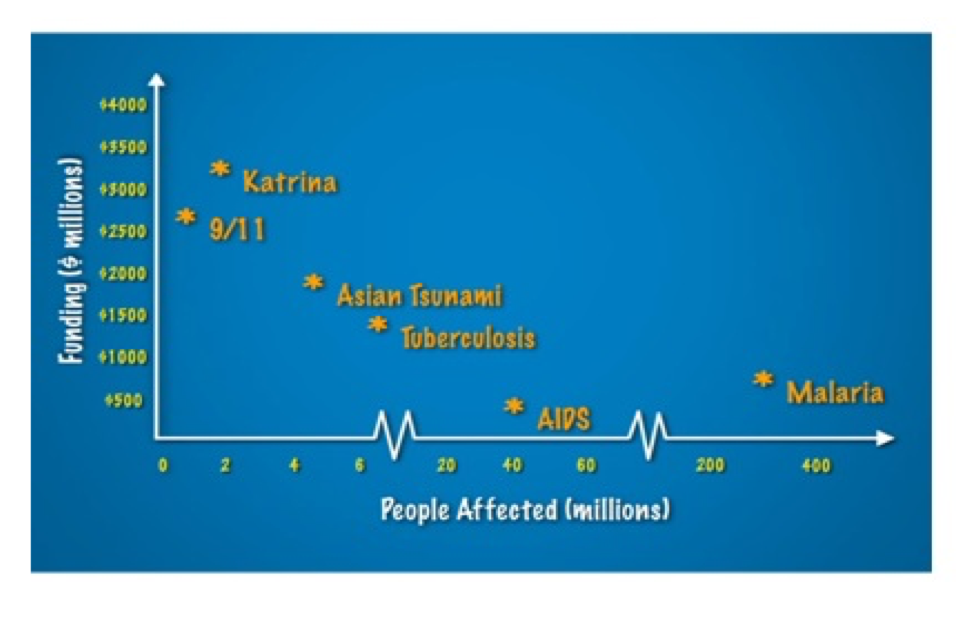
Nobel Prize winner, Daniel Khaneman [3]said that ninety-five percent of what we think happens at an unconscious level and sensory impressions and their emotional responses are anchored in some parts of the brain whose origins date back hundreds of millions of years. The sensory brain (also called the reptilian or lizard brain) and the emotional brain (mammalian) work together. The rational brain (or that of the human) is considerably more recent, in evolutionary terms since it has developed about 100,000 years ago.
Understanding what really happens in our brains (through modern technologies like MRI, CT scan and micro-expression facial reading) changed everything, not only from an evolutionary or cognitive perspective, but especially from the philosophical and moral point of view that is behind the philanthropic behavior.
Antonio Damasio [4] , a Portuguese neurologist, had the audacity, based on neuroscience discoveries, to refute in a wonderful book the true foundation of modern Western identity. The ‘cogito ergo sum’ of Descartes, Damasio argues, is a big mistake and a deception. In fact, our decisions are taken not by the ‘cogito’ or rational part of the brain, but from that part of the brain that deals with emotions, which in turn are activated by the body on the basis of sensory inputs (sight, hearing, taste, smell, touch).
In short, we decide on instinct or in a ‘blink’, as Malcom Gladwell[5] would say, and only after we act does the rational part of the brain formalise and explain our decision through words and concepts. This finding, subsequently confirmed in recent years by many studies and experiments, has radically changed the way advertising and marketing are done. And should also change fundraising.
We now have evidences that emotions – the etymological origin of the word is from the Latin ‘e-movere’ "move out, remove, agitate’- are the ones that decide if a donor will press the button ‘donate’ or the ‘like’ on Facebook, if he or she will dial a phone number to sponsor a child, send a text message or if they will open their wallet to a young stranger at the subway exit.
More importantly, emotions, as repeatedly demonstrated by various studies, are universal; they are a human trait that is hardwired in our body and in our brain, and they are trans-cultural. The father of evolution Charles Darwin was surprised by noting the similarity between the same expressions on his child’s face and on that of monkeys. [6] Darwin spent many years of study observing patients in various psychiatric hospitals, comparing their expressions with those of animals. As the title of his book, ‘The Expression of the Emotions in Man and Animals’, explains Darwin believes and is able to prove scientifically that animals feel our own emotions. Emotions are programmed or hardwired into the DNA of the biological species and are not a cultural thing: they activate neural circuits, trigger
similar behavioral reactions and physical and physiological changes experienced by both animals and men.
But the most important part of Darwin's work is when he showed that emotions - as they are expressed or can be identified through the expressions of our face - are universal, i.e. they are not determined by culture or geographical context. As will also be demonstrated in subsequent studies by Ekman and others, the emotions are the same even in populations that have never had or known written language and, as some researchers have recently discovered in California, emotions are the same even among people who are blind [7] Emotions are not learnt like the language, writing, or other rational forms.
However, it was not until almost a century after Darwin, in the 60's, that Paul Ekman [8] and Wally Friesen of the University of San Francisco were able to classify all of the underlying facial expressions linked to emotions.
The two scientists have developed what is called FACS (Facial Action Coding System) which has codified the movements of the 43 facial muscles that create 23 units of action that play the muscles of our face when we feel certain emotions. The Ekman system, on which the successful Emmy-nominated TV drama series ‘Lie to Me’, was based, has systematised emotions - expressed through the micro expressions of the face - that take place in the unconscious part of the brain. Ekman has made the first connection between the decisions and actions we take every day on one side and the emotional part activated in the brain on the other.
The true feelings trigger our behaviour and our very first decisions (gut feeling) before we realise it. Later we rationalise and give an explanation and a name to how and why we acted in a certain way.
In June 2014, Paul Ekman sent a survey to 248 of the most active emotion researchers in the world to establish a consensus on universality of emotions.
Of those who responded, 90 per cent agreed that there are universal emotions: emotions that all humans, no matter where we live or how we were raised, have in common.
- 91% said anger is universal
- 90% said fear is universal
- 86% said disgust is universal
- 80% said sadness is universal
- 76% said enjoyment is universal
The most interesting development of Ekman’s research is the project Atlas of emotions [9], in collaboration with the Dalai Lama. As Ekman said, ‘It was created to increase understanding of how emotions influence our lives, giving us choice, (at least some of the time) about which emotion we are experiencing and how our emotions influence what we say and do. While emotions are central to our lives - providing the joy, alerting us to threats, a force for change, a warning against what is toxic, and calling to others for help - we do not choose what to feel or when to feel it.’.
Recent discoveries in neuroscience applied to marketing and fundraising show how our brain - both when we buy a product and when we make a donation or subscribe to a petition - decides on the basis of some specific emotions activated in that part of the brain called the meso-limbic system -the same one that controls our heartbeat, oversees the memories and reacts to stimuli and rewards such as food, sex, or money.
Therefore, understanding which emotions drive people to donate and activating the right emotions is the only way for effective fundraising. But not every emotion is the same, neither is the way we used them in fundraising.
[1] Andreoni, James (1990). "Impure Altruism and Donations to Public Goods: A Theory of Warm-Glow Giving". Economic Journal 100 (401): 464–477. JSTOR 2234133.
[2] Dan Ariely, Predictably Irrational: The Hidden Forces That Shape Our Decisions, second edition in 2012., HarperCollins, 2008
[3] Daniel Kahneman, Thinking, Fast and Slow, Farrar, Straus and Giroux, 2011
[4] Antonio Damasio, Descartes' Error: Emotion, Reason, and the Human Brain, Putnam, 1994.
[5] Malcom Gladwell, (2005). Blink : the power of thinking without thinking. New York: Little, Brown
[6]Darwin Charles, (1998) The Expression of the Emotions in Man and Animals, 3rd edn, London: Harper Collins.
[7] Bob Willingham, David Matsumoto, “Spontaneous Facial Expressions of Emotion of Congenitally and Noncongenitally Blind Individuals”, Journal of Personality and Social Psychology, 2009, Vol. 96, No. 1, 1–10
[8] Paul Ekman, Emotions Revealed,: Recognizing Faces and Feelings to Improve Communication and Emotional Life, Second Edition, Holt Paperbacks; 2nd edition 2007
3.2. The human brain and how it works
Emotions are located in the most primitive part of the brain, or limbic system that operates by influencing both the endocrine system and the nervous system[1]. This system - in particular, the amygdala and the hippocampus - through training and memory recall, operates and activates many of the so-called primordial decisions (such as escape when we face danger or fight to defend ourselves, crying, laughing, etc.). The same system stimulates the release of ‘drugs’ or chemicals in the blood (dopamine, epinephrine, etc.) involved in reward and punishment.
The limbic system is closely connected to the prefrontal cortex (the one which presides over movements and decisions) and therefore there is a close connection between the decision based on emotional reactions and actual physical movement (the word emotion has the same origin as the word movement). While the hippocampus ‘remembers’ facts, recalling similar experiences, the amygdala will judge their emotional value. The amygdala then provides each sensory stimulus (sight in the first place, but also smells, sounds, touch, etc.) with the right level of attention, enriches it with emotions and, finally, stores it in the form of memory. The hippocampus then, through the amygdala stimulation, activates the nervous system (heart rate, breathing, salivation, tears, etc.).
And then the motor system (action) is activated well before the cortex (the part of brain formed more recently and presiding over language, calculation, etc.) is activated.
[1] Le Doux, Joseph The Emotional Brain (The Mysterious Underpinnings of Emotional Life), Simon & Schuster, Touchstone 1998.
The three parts of the emotional brain, according to Dan Hill

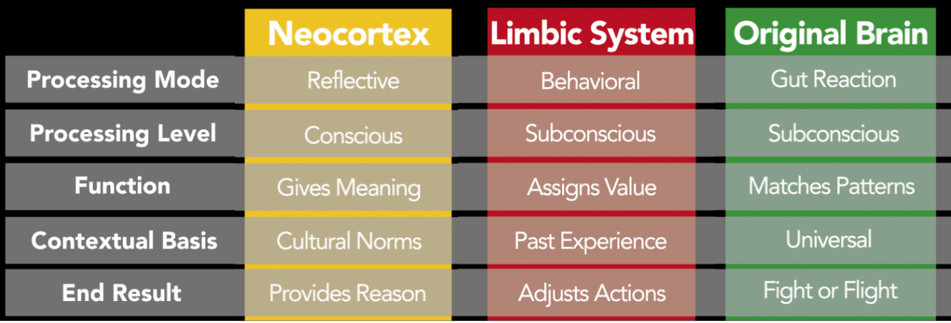
Neurosciences are an endless source of discoveries about how our minds works. Among other things scientists have discovered the mechanisms that trigger seemingly irrational behaviour such as compassion for others or giving money for nothing in return. Over the past twenty years, numerous studies have helped to map which part of the brain is involved when we do certain things, including when we decide to donate to some causes or organisations.
Among the pioneers who have applied or contributed to apply the discoveries of neuroscience to generosity and identify mechanisms that govern the decision to donate, we can cite at least three scientists, or rather three groups of scientists. 1) The first is a group of Italian researchers from the University of Parma - led by Professor Giacomo Rizzolatti [2]- who have discovered in the ‘90s the so-called ‘Mirror Neurons’. These ‘neurons’ light up ‘when we see others suffering, laughing, etc., even when we observe them in virtual form, for example in a photography or on a TV screen, or we imagine them while we listen to a story’;
2) The second scientist is Paul Zack [3]a neuroscientist and an economist at Claremont University in California who discovered the functioning of the so-called ‘love molecule’, oxytocin a hormone that increases our capacity of empathy toward others and increases in our blood for example when we are making a donation or an act of generosity toward others;
3) The third is a group of neuroscientists from the universities of Bethesda in Maryland, Genoa and Rio de Janeiro. [4] They have shown which part of the brain (mesolimbic system) is activated when we give money, by releasing positive and chemical stimuli equal to those when we receive a monetary reward, we eat a good meal or carry out activities such as sexual intercourse.
All these three discoveries shown clearly that emotions – activated by sensory stimuli – are the drivers of altruistic behavior and that the experience of giving is rewarded by specific neurotransmitters and hormones released by the brain that make us feel better. Therefore the implications for a more donor-centered approach to fundraising is to understand, analyze and study the emotions and tailor make fundraising appeals targeted to those who can respond better to these emotions.
[1] Moll Jorge, Krueger Frank, Zahn Roland, Pardini Matteo, de Oliveira-Souza Ricardo, and Grafman Jordan, Human fronto–mesolimbic networks guide decisions about charitable donation, http://www.pnas.org/content/10...
[2] Giacomo Rizzolatti, Corrado Sinigaglia, Mirrors In The Brain: How Our Minds Share Actions and Emotions. New York: Oxford University, 2008
[3] Paul Zack, The Moral Molecule. The source of Love and Prosperity, Bantam Press, 2012
[4] Moll Jorge, Krueger Frank, Zahn Roland, Pardini Matteo, de Oliveira-Souza Ricardo, and Grafman Jordan,
Human fronto–mesolimbic networks guide decisions about charitable donation,
http://www.pnas.org/content/10...
3.3. Which are the important emotions and why?
Based on the major findings from neuroscience, in particular the work of Paul Ekman, Dan Hill. [1]has managed to synthesize the key emotions that drive our decisions and our actions, and then identified the marketing strategies that needs to adapt to this new paradigm.
First, based on Hill and Ekman, let’s define emotions, a term that is likely to be left too broad or based on intuitive interpretations.
Emotions have four universal characteristics:
a) a perceptual component that includes physical sensations and chemical changes in the brain and is activated in our body from the brain (via for example the release of hormones in the blood such as oxytocin, cortisol, etc.);
b) a reflective component, through a conscious or intuitive thinking that is activated in response to sensory stimuli;
c) a behavioural component, through expressive reactions on our face (such as smiling or crying) and with specific actions (I have to run or fight?);
d) a sensory component such as images, sounds, etc. that trigger an emotional response.
Hill has identified six key emotions [2]
• Happiness
• Surprise
• Anger
• Disgust
• Sadness
• Fear
The six key emotions as identified by Hill and Ekman can be imagined as a spectrum: they can be high intensity or low intensity. For example, we can feel pain - high intensity - or just be sad - low intensity, or we may feel annoyed (low intensity) or be angry (high Intensity). This is very clear in the Atlas of Emotion developed by Ekman mentioned earlier. The studies of Ekman and Hill proves that six core emotions, and only these six, are those that really matter in activating people and igniting behaviour such as the action of donating. In the Emotionmeter I summarized the emotion spectrum using Dan Hill’s classification so that six key emotions are aligned along the spectrum of intensity, low or high.
[1] Dan Hill, Emotionomics, Leveraging emotions for business success, Revised edition,. Kogan Page, 2008; Dan Hill, About Face. The secrets of emotionally effective advertising. Kogan Page, 2010
The Emotionmeter
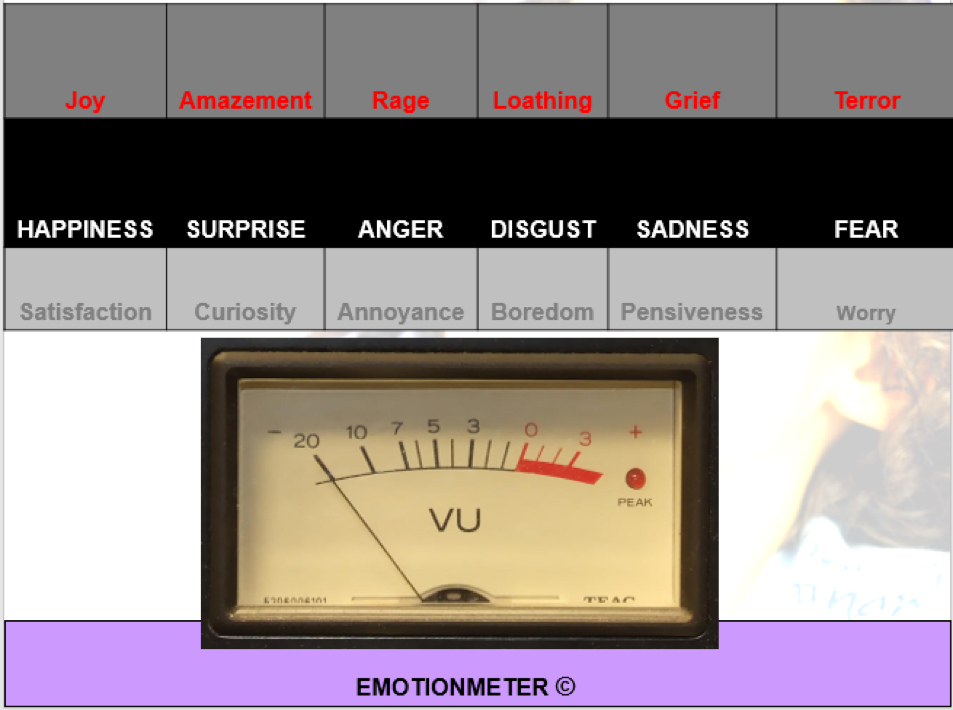
Adapted from Hill and Ekman
High intensity / low intensity
What is important about this tool is that it shows how emotions are positioned in a spectrum that ranges from a low intensity to a high intensity and each one ignites a type of reaction and action, depending on their intensity and combination. For example, some images, words or sounds can only generate a feeling of general discomfort, but do not make us angry enough to take an initiative (i.e., ‘bang a fist on the table’). A message or an image can leave us so amazed, terrified or in pain to make us feel stuck or paralysed, and then not able to do anything, to not make any decision or action. Finding the right emotional level is crucial for donor-centred fundraising and for our donors.
The second consideration is that the six key emotions are like the basic colours or primary colours (yellow, red, green, etc.). As with colours we mix them to produce other colours such as purple, orange, etc., – the full range of emotions. By combining the different possibilities, the mix of the key emotions, Dan Hill has provided a more comprehensive framework for primary and secondary emotions. What is important is that these emotions are all located in specific areas of the brain that are active and ignite chemical and physical actions. Therefore, these are not theoretical insights or arbitrary classifications of feelings, but biological and chemical measurements of where and how our emotions are formed and activated in our brain.
Negative and positive emotions
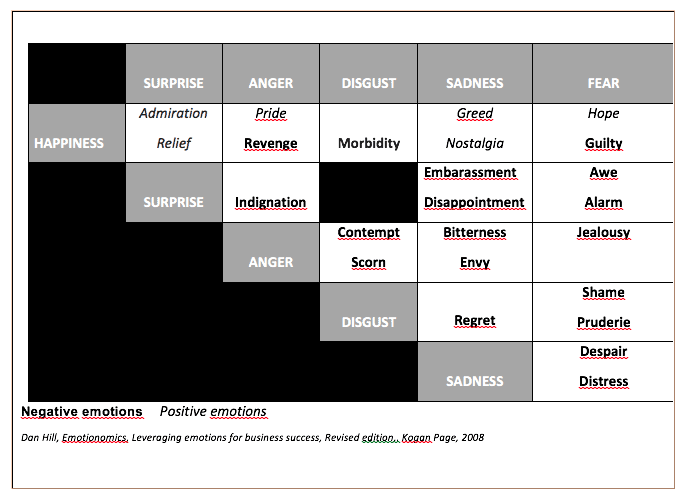
As you can see, only six of the thirty emotions are positive (admiration, relief, pride, greed, hope, nostalgia) while most are negative. According to Dan Hill, this is due to the evolution of our brain (and indeed, as we have seen, the meso-limbic system is among the most ancient parts of our brains). The increased susceptibility to negative emotions derives from the need for survival of the species, and therefore the need to have a greater number of tools to react to events and negative situations that can help us to decide whether, for example, in front of a danger we must fight, or escape.
Understanding emotions and their use can be a powerful tool for fundraising and to make the donor experience consistent and effective, so avoiding to bombarding donors with a quantity of annoying messages via telephone, mailing and TV.
• Most of the key emotions we feel are negative (four out of six key emotions are negative: anger, sadness, disgust and fear), one is neutral (surprise) and one is positive (happiness);
• Negative emotions generate more attention and audience involvement than other emotions. In two campaigns that use positive and negative emotions, the latter always get better results in terms of response and donations; however, use of pure negative emotions will not necessarily lead to the act of donating if there is not a positive outcome that can be imagined as a solution to the negative emotions.
• The possibility of contributing to solve a problem by means of a donation generates a positive emotion (happiness) and this is activated by substances such as oxytocin and dopamine released into the blood from the brain.
• Emotions are not to be confused with feelings, which are those emotions that make it into our consciousness. Emotions are measurable through a variety of instruments like EEG, MRI, etc. that shows the actual sub-conscious experience of the brain while we watch a video, listen to a story etc. Feelings are what the people are retrieving sometime after this experience. Feelings are what is left from emotions and recorded in our memory so that when we recreate the same experience emotions are unfolded one more time. Emotions make you act, while feeling make you remember and act again if solicited.
• Emotions are also the basis of memory formation through the amygdala. So when we activate a strong enough emotion through our messages, we can set in motion even the memory storage mechanisms, which means that we can re-use the emotions that we ignited initially, soliciting or reactivating the same actions and behaviors, such as a new donation or a legacy.
• Emotions are not generated in isolation, but are always situated along a spectrum of intensity and in combination with some other emotion (emotions can be at high and low intensity and emotions in real life are combined resulting in other states like embarrassment, guilt, melancholia.
3. 4. The hormones of giving: oxytocin and cortisol.
A key discovery in brain-related altruistic behavior come from neuroscientist and economist, Paul Zak. [1]What Rizzolatti found using MRI– i.e., brain areas like pre-motor are reached by an increased inflow of blood when we are moved by an emotion- Paul Zak found in the blood itself. In fact, Zak discovered that there are two basic substances or hormones released by the brain in certain situations.
The first is oxytocin, a hormone released by women during childbirth, but also when we feel empathy for others who are suffering. The second is cortisol (cortisone derivative) that increases in our blood in stressful situations and serves to focus our attention. Zak has spent his life trying, measuring and explaining what happens to the chemical level in our body when we feel emotions or feel compassion for our fellow man. By measuring the levels of the two hormones in our blood, Zak has discovered that empathy and our propensity to donate depend on the level of certain chemicals (issued or stimulated by the brain) in our blood. [2]
In one experiment, for example, he asked two distinct groups to donate to some causes and organisations after an injection. The first group received a dose of oxytocin, and the second group only a placebo. The result? The first group proved 80 per cent more generous in donating not only in general but also in the average gift.
In a second experiment. [3] Zak measured what happens to a group of people watching a very emotional video about a child with brain cancer and its story told by his father. In short, Zak has discovered that our brain, when we see or hear certain stories, produces two chemical elements:
1. Cortisol, a chemical that helps to be more 'attentive, to focus our senses such as sight or hearing. Cortisol is active in the presence of stressful situations. Therefore, the more we are stressed, the more we produce cortisol and the more we pay attention to the stimulus we face (a story, an image, etc.)
2. Oxytocin, a hormone linked to empathy that makes us connected with others. The more oxytocin is released in the blood the more we feel ‘empathetic’ for this or that person (even for a ‘virtual’ person we’ve not met but whose story we hear being told).
Participants in an experiment conducted by Zak were asked, after looking at the video, to donate to a range of organisations that deal with research and assistance to children with cancer. Results? People with the highest level of cortisol and oxytocin were those more inclined to donate. Not only that, the level of oxytocin in the blood can also be used to predict the level of contribution, i.e. how much each person donates to a particular cause or organisation. This discovery, Zak says, emphasises that our brains are hardwired to respond to certain stimuli, especially to the situation of other human beings, through the stories that are told. It also explains that to donate to a person, to support a cause or an organisation depends on being able to ensure, through the stories, and that our brain releases an adequate level of cortisol and oxytocin.
When participants to the experiment see images of the father and son walking hand in hand, no area of the brain is activated because there is nothing to focus attention on or feel empathy about. When the father begins to talk about his son's situation and how he feel knowing that only a few months of his life remains then the meso-limbic system is active and a high level of cortisol and oxytocin are released in the blood. Zak also measured heartbeat, the level of sweating, etc. He got the same results.
It is stories and their emotional content that activates the predisposition to donate, not the creative messages, the statistics, the brand or the logo.
[1] Paul Zack, The Moral Molecule. The source of Love and Prosperity, Bantam Press, 2012
[2] Barraza, J. A.; Zak, P. J. (2009). "Empathy toward Strangers Triggers Oxytocin Release and Subsequent Generosity". Annals of the New York Academy of Sciences 1167: 182–189.
[3]
3.5. Understanding emotions and using them effectively
Negative emotions are dominant in our behaviour and in our brains for biological and evolutionary reasons. The research in neuroscience and marketing and practice in fundraising shows that these emotions works better to generate more responses to campaigns and appeals. However, the combination with positive emotions also have a crucial role in activating donors and supporters.
- Fear and sadness are very strong emotions that can mobilise many donors. Fear can generate responses by activating empathy with negative stories and conditions experienced by others or positioning a donor in face of the dangers and risks that may affect him/herself (e.g., violence, diseases, etc.).
- Sadness activates mirror neurons through words and images and can reactivate in our memories nostalgic or melancholic moods that can stimulate the repeat of an action to make us feel better again. Nostalgia can play a very strong role in fundraising, particularly in promoting legacies.
- Anger and disgust are two powerful emotions because of their primordial origin. These two emotions are frequently used by organisations such as Greenpeace and Amnesty International, and can be applicable to all causes to generate an immediate action-oriented response.
- Surprise is a fundamental emotion to attract attention and to anchor the message in the memory of the donors. However, surprise alone or in the absence of a strong call to action may not be effective because it can lead to paralysis and confusion.
- Happiness. If negative emotions are dominant in our brain, happiness and positive emotions are key in fund raising. The use of humor and comedy mixed or opposed to negative emotions are the basis of the formula for success of fundraising campaigns such as Comic Relief.
Ten techniques or principles can help to develop more emotional and more effective fundraising. These are ten principles based on psychology, communication and marketing experts like Cialdini, Dan and Chip Heath and Dan Hill and mixed with my own fundraising practice, are very effective in fundraising.
- Reciprocity: creating a kind of ‘obligation’ from unexpected acts of gratitude such as a gift or a thank you for your support and donation. Beyond the use of premiums and gadgets, whose effectiveness is still unclear in fundraising, surprising the donor with a personalised communication based on gratitude for his/her donation or celebrating important events and achievements during the donor’s lifetime significantly increases the value of donations and loyalty over time. But please remember that a genuine reciprocal gift is always best, that transparent gimmicks can be seen though and will often do more damage than good.
- Scarcity: providing donors with ‘exclusive offers’ with specific awards (mention in the website or in the annual report, possibility of participate to special events and visits), helps to increase the level of donations and loyalty over time
- Authority: use of verifiable credentials (statistics or experts) are elements that help make our messages credible and authoritative. In particular, the ‘money back’ guarantee formula can deliver solid results and add credibility.
- Consistency: Getting commitments, including non-financial actions such as signing petitions or volunteering, helps in transforming occasional participants into regular donors later. The so-called "trysummers"- who want to experience before making a donation - are more inclined to donate after they signed a petition or perform similar non-monetary acts.
- Sympathy: one of the most powerful mechanisms to donate is the pressure or the influence of people around us (friends, relatives, etc.)
- Imitation or social proof: there are behaviours and actions we like to imitate if we see others like us who perform them.
- Authenticity: it is part of the behaviour of modern consumers to seek unique experiences more than products or brands. Using real time information, images and traceable communication (GPS and Google map based) that connect donors directly to beneficiaries are ways to make our appeals more authentic.
- Transformation: ‘before and after’ always works in activating emotional mechanisms, especially using images
- Tangibility activating the tactile part (objects) or evoking objects through images and words has a strong ability to connect a donor with causes and organisations. The ORS (oral rehydration) sachet or bracelet to measure malnutrition from UNICEF are good examples of tangible aids to fundraising
- Urgency: building a sense of urgency or putting a deadline to our fundraising increases the response.
3.6. Technologies to better understand emotions
Developments in neuroscience in recent years have shown that people are intuitive in their decisions and decide which actions to take based on sensory and emotional stimuli. Market research, however, has developed an approach based on asking consumers and donors via questionnaires and focus groups for example, if and how much they like this or that advert or if they are willing to buy a product or not or to donate. The assumption has been that if somebody declares they prefer certain brands or remembers a product or an advertising campaign, this will result in a purchase behaviour (or in a donation). This is not true, because responses reveal the rational part not the insight, sub-conscious reasons. Traditional market research usually invites participants to give marks to specific questions or statements (for example: "What motivates you to donate: from 1 to 10...’). This is an invitation to participants to provide rational answers or intellectual arguments that often do not reveal the true motivations behind certain actions or behaviour. As JP Morgan said ‘A man makes a decision for two reasons: the good reasons and the real reasons’: the good reasons are the rational justification to behaviour and real reasons are the behaviour itself.
Neuroscience and behavioural economics suggest that the real reasons are often found in what people cannot or will not say. Consider the mistake often made in exit polls: voters are often ashamed to say for whom they truly vote.
There are now five main types of research techniques that can help us to identify the real emotions at work:
- the electroencephalogram (EEG)
- magnetic resonance imaging (fMRI)
- eye tracking
- skin conductance
- facial micro expressions coding (FAACS) [1]
These five main technologies are often combined with the collection of other sensory stimuli like the heartbeat. Proper neuro-marketing research can be used in combination with 25 different data sets or more per second, during which a subject is looking at a video or a piece of advertising. This type of research tool is much more effective in telling the true picture of what’s is going on in the mind of a donor and what could trigger his/her intention to donate.
Research of this type helped UNICEF in Italy to understand that a TV spot for legacies (No 2) was much more effective for the audience they wished to target (65+ year old, without children) – because it generates better emotional arousal especially in the Call to Action (CTA) than the alternative spot (No 1) and therefore helped to tailor UNICEF’s message better.
Fig.– Emotional activation while watching spot no 2

Fig.– Emotional activation while watching spot no 1
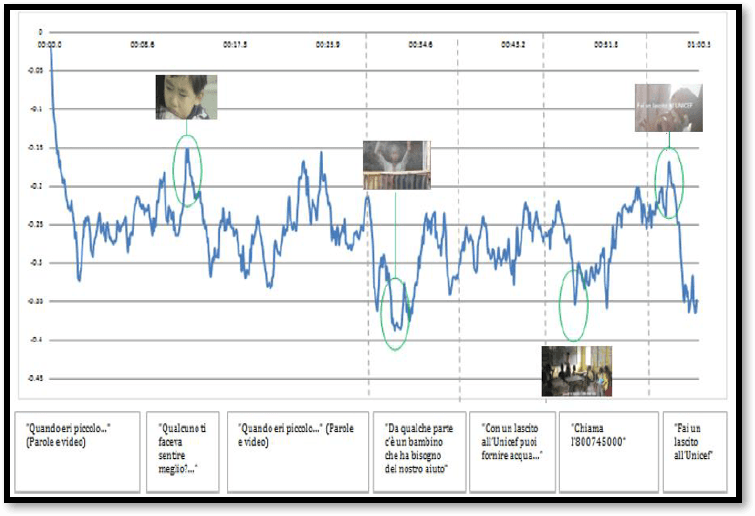
[1] Dan Hill and Aron Levin, “Applying facial coding to ad testing. On the face of it”, in QUIRCK’s, March 2013, http://www.quirks.com/articles/2013/20130309.aspx
3.7. Emotional loyalty
Emotions are the key for a healthy and long-term sustainable relationship with donors.
Customer attrition in the commercial world is substantially lower than in the nonprofit sector. According to Bloomerang, in the commercial world the average customer attrition is 6% while in the nonprofit sector is 43%. [1]The sample or the methodology of Bloomberg can be questioned, but clearly the gap between the two areas is so wide that we need to understand why charities lose most of their regular donors (and a large majority of first time donors do not repeat their gift) while business is able to keep the large part of their customers and make them buy again. One of the key insights [2] that has been discovered in the commercial world is that emotionally satisfied customers are substantially more profitable compared to rationally satisfied or dissatisfied customers.
Fig.– Emotionally satisfied customers are more valuable than rationally satisfied
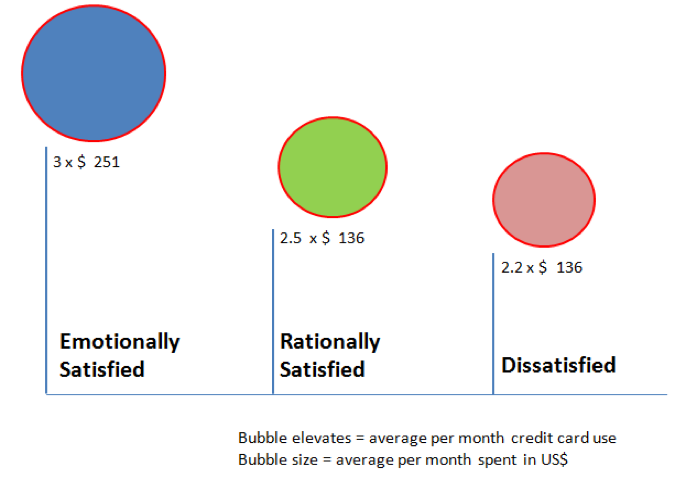
B. Pearson, The Loyalty Leap, Penguin
The donor attrition or donor churn is a well-known phenomenon and a dilemma for charities. Notwithstanding a number of research and evidence on donor’s loyalty and how to develop donor relationships by Adrian Sargeant [3] and Ken Burnett, charities are still struggling with the retention of donors.
The answer is not only a well-executed donor care programme (although charities can and must always improve) and of course finding the right target audience to begin with, but it is about narrowing the emotional gap with donors.
Think about it. The first meeting with donors (or the first date) is all about emotional engagement: charities have the power to trigger powerful emotions like anger, fear, and sadness and make donors feel happy through their gift. This thanks to the incredible experience that a donor lives through, with a myriad of senses stimulated by the power of the stories we tell with our images, sounds and words.
What happens next? They receive a (personalised?) thank you letter or a note (maybe a call or an email), some newsletters or a glossy report, more appeals and requests for funds or requests to increase their donation. Like in the saddest love stories, the spark of the first date is gone; there is no more emotion in the relationship, therefore many donors look for other experiences or new relationships.
Many fundraisers believe that a prompt acknowledgment and a ‘thanks for the donation’, a regular update on what the donation has helped to achieve (and don’t forget to ask again) will ensure that a donor will stay with a charity forever. They are wrong.
Part of the problem of charities being disconnected with donors is in the formulaic approach fundraisers use (the £3 a month a month offer, the welcome pack, the reactivation of lapsed donors email, etc.). In fact, it is often the formula that sometimes is implemented just like an ‘output’ of a production process that has little if not a negative effect on donor loyalty. The risk is to transform the donation experience in a supply chain. With clear negative impact on donor experience.
The second part of the problem is that, as we have seen, emotions drive people to act and to donate and in fact fundraisers spend most of their resources in conceiving new appeals, looking for stories and finding the right words, images or videos to trigger the donor’s emotions to engage with their cause. But then, after donors give for the first time, charities devote no resources or little resources to keep the donors because they imagining a different type of donor, like a Frankenstein transformation: the donor become a donor sapiens.
These imagined donors - according to a stereotypical idea of a donor- are always well informed because they read the newsletter they receive and go to website; they donate on time and they know when to renew their gift; they are altruistic so they don’t need to be thanked; they clearly know that charities need to cover their overhead costs and they are happy to be over solicited; they enthusiastically engage their friends in the causes they support, etc.
Unfortunately, these donors do not exist in nature, or they are very few. The majority of donors are very much limited in their attention and memory. In fact, what fundraisers often ignore is that emotions not only drive actions (and donations) but also strongly contribute to memory formation, so that every time a donor gets in contact with our cause he or she is expecting to be engaged by the same emotions not by our organisational blurbs.
If we look closely to the reasons why donors stop giving, several of them mentions that they have no memory of supporting the organisation or they feel that the organisation they support did not need their money anymore!
In the business world, there is a clear understanding that today’s profit margins rely heavily on the level of customer emotional engagement. TD Bank Turns ATMs into Automated Thanking Machines [4]is an example of a clear strategy to get more enthusiast customers who will love and do more business with the TD Bank. As the CEO Ed Clark explains, “The great thing about our model is, if I put a branch on a corner in New York City, I know five years later I will have more than 25% of the local business, because at some time in that five years someone will come by at 4:02 pm. Their branch will be closed, they’ll look across at our store, this beautiful store, there will be someone giving dog biscuits to somebody’s dog, they’ll walk in and there’s a greeter that’s unbelievably friendly, and they’ll say, ‘So why am I banking with the guy across the street?’
You can see video 2.14.3. ‘Sometimes you just want to say thank you’ in the Emotional Fundraising Showcase, here.
The other mistakes is that fundraisers imagine that a donor stops giving suddenly, as a consequence of a rational act. The data and statistics cannot explain why and how somebody so engaged and generous for many months and years decides at a certain point to stop a donation, after all the newsletters, calls and letters they have received.
The point again, is that charities have in mind again a donor sapiens, somebody very rational that takes a decision to stop his or her support by assessing the pros and cons. The reality instead is that donor’s disaffection and attrition are not an isolated decision in a given time, but the sum of bad experiences (or no experiences) that the donor has had with the organisation.
In a study by Bain and Company (https://goo.gl/b0TGD1) they found out that ‘customers have already been primed to leave by the time an alternative attractive offer arrives, so that any change in their lives can bring the decision to a head. The episodes that condition a customer to dislike his or her provider and the actual decision to leave can be years apart” [5]
The other interesting insight is that there is a thin line between a customer who declares himself/herself to be ‘satisfied’ and the moment he or she switches to a competitor. Because it’s not what the customer says but what they experience that matters. Therefore, it doesn’t matter how many thank yous, surveys and newsletters are sent if the donor doesn’t feel emotionally engaged.
Francesco Ambrogetti 2016
[1] https://bloomerang.co/retentio...
[2]Brian Pearson, The Loyalty Leap: Turning Customer Information into Customer Intimacy, Portfolio; 1st edition, 2012
[3] Adrian Sargeant, Elaine Jay, Building Donor Loyalty:, The Fundraiser's Guide to Increasing Lifetime Value, Jossey-Bass, 2011
[4] http://www.forbes.com/sites/stanphelp...
[5] http:// www.bain.com/publications/arti...
Most of the content in this section has been adapted from Francesco Ambrogetti’s brilliant book Emotionraising. How to astonish, disturb, seduce and convince the brain to support good causes. It has just been published in English and is available now on Amazon, here. https://goo.gl/cxhacx
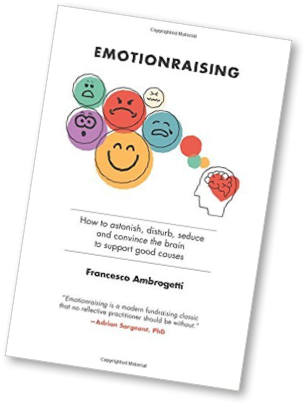
Francesco Ambrogetti
Francesco returned to Italy in 2015 after 20 years abroad, as marketing and fundraising director of UNICEF in Italy. Francesco has 20 years of senior‐level fundraising leadership experience with major international charities including UNICEF, UNAIDS, UNHCR, MSF, WWF, Red Cross. His experience extends worldwide and includes raising billions of dollars in Europe, Africa, Asia and Latin America. He launched the campaign Schools for Africa for UNICEF that raised over $200 million until now.
He is professor of fundraising at Bologna University and frequent speaker at international & national fundraising congresses and frequent blogger and author of articles on fundraising and marketing. He is also author of the book ‘Manuale di fundraising per le organizzazioni nonprofit’ (Handbook on fundraising for nonprofit organizations) published in 2005.
